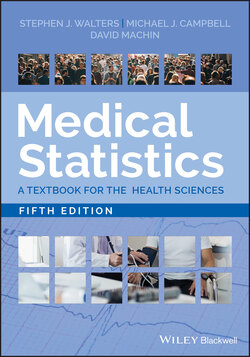Читать книгу Medical Statistics - David Machin - Страница 99
Probability Distributions for Discrete Outcomes
ОглавлениеIf we toss a two‐sided coin it comes down either heads or tails. In a single toss of the coin you are uncertain whether you will get a head or a tail. However, if we carry on tossing our coin, we should get several heads and several tails. If we go on doing this for long enough, then we would expect to get as many heads as we do tails. So, the probability of a head being thrown is a half, because in the long run a head should occur on half the throws. The number of heads which might arise in several tosses of the coin is called a random variable, that is a variable which can take more than one value, each with a given probability attached to them.
If we toss a coin the two possibilities; head (H) – scored 1, or tail (T) – scored 0, are mutually exclusive and these are the only events which can happen. If we let X be a random variable that is the number of heads shown on a single toss and is therefore either 1 or 0, then the probability distribution, for X is: probability (H) = ½; probability (T) = ½ and is shown graphically in Figure 4.3a.
Figure 4.3 Examples of probability distributions. (a) Probability distribution for the number of heads (X) shown in one toss of a coin. (b) Probability distribution for the number of heads (Y) shown in two tosses of a coin. (c) Probability distribution for the number of heads in four tosses of a coin. (d) Probability distribution for the number of heads in ten tosses of a coin.
What happens if we toss two coins at once? We now have four possible events: HH, HT, TH, and TT. There are all equally likely and each has probability ¼. If we let Y be the number of heads then Y has three possible values 0, 1, and 2. Y = 0 only when we get TT and has probability ¼. Similarly, Y = 2 only when we get HH, so has probability ¼. However, Y = 1 either when we get HT or TH and so has probability ¼ + ¼ = ½. The probability distribution for Y is shown in Figure 4.3b. The distribution for the number of heads becomes more symmetrical as the number of coin tosses increases (Figures 4.3c and d).
In general, we can think of the tosses of the coin as trials, each of which can have an outcome of success (H) or failure (T). These distributions are all examples of what is known as the Binomial distribution. In addition, we will discuss two more distributions that are the backbone of medical statistics: the Poisson and the Normal. Each of the distributions is known as the probability distribution function, which gives the probability of observing an event. The corresponding formulas are given in Section 4.7. These formulas contain certain constants, known as parameters, which identify the particular distribution, and from which various characteristics of the distribution, such as its mean and standard deviation, can be calculated.
